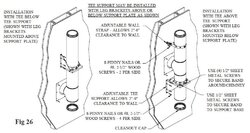Fine folks, hi, this is the first of many more questions from me most likely ... I've read several moderator messages stating that there aren't any stupid questions so I hope I won't prove that point wrong! I've lurked a little while and read as much as I possibly can concerning wood stove installation, selection and utilization and I must say that this site is totally terrific.
I am installing our first wood stove ( I hope to post the whole adventure with pics a little later ) and I am wondering about the framing for the support box. The stove store's owner ( a Regency dealer who really seems super sharp ) has told me that the 12x12 support box can be framed by regular wood studs. Although I don't doubt him at all (again he seems super sharp and extremely experienced at this) I find myself fretting about putting regular studs right up against the support box. I'm wondering whether in even extreme situations that has proven problematic? I'm also wondering whether it would be beneficial to use steel studs or something even stronger than studs like square 16 -18 gauge steel tubing ( I can weld really well and custom creating a square steel frame for the support box would be super simple for me.
I sometimes have the tendency of overthinking things (especially with safety related stuff) and am likely letting that happen here too however now is the time to really think these things out and act accordingly. Any advice you all have would be appreciated and ultimately used. If it matters, the stove is getting installed into an alcove. Thanks in advance for any advice at all.
I am installing our first wood stove ( I hope to post the whole adventure with pics a little later ) and I am wondering about the framing for the support box. The stove store's owner ( a Regency dealer who really seems super sharp ) has told me that the 12x12 support box can be framed by regular wood studs. Although I don't doubt him at all (again he seems super sharp and extremely experienced at this) I find myself fretting about putting regular studs right up against the support box. I'm wondering whether in even extreme situations that has proven problematic? I'm also wondering whether it would be beneficial to use steel studs or something even stronger than studs like square 16 -18 gauge steel tubing ( I can weld really well and custom creating a square steel frame for the support box would be super simple for me.
I sometimes have the tendency of overthinking things (especially with safety related stuff) and am likely letting that happen here too however now is the time to really think these things out and act accordingly. Any advice you all have would be appreciated and ultimately used. If it matters, the stove is getting installed into an alcove. Thanks in advance for any advice at all.


